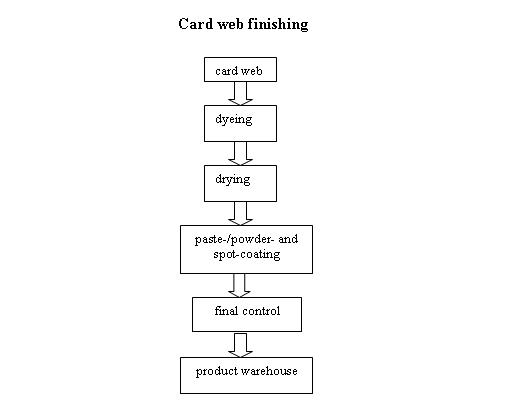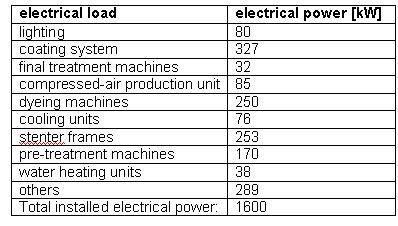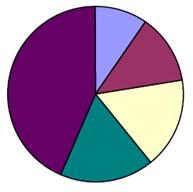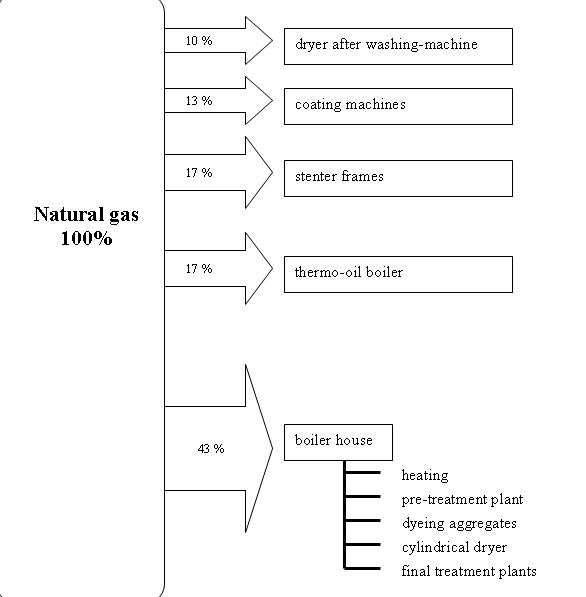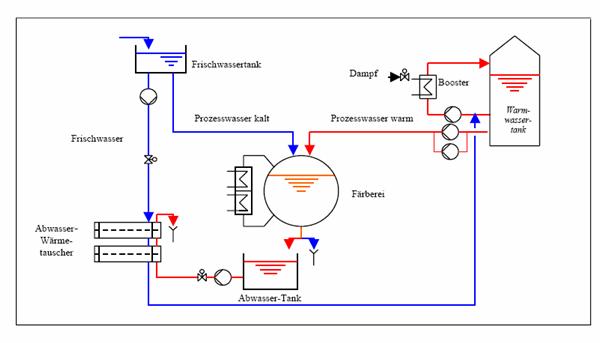Kufner Textilwerke (Germany)
Back to EFFICIENCY FINDER
Back to Information about cotton and bast fibres
Back to the Case studies
- 1. Case study or Built example
Case study
- 2. Industry Sector
Textile finishing of woven fabric, knitware and card web
- 3. Industrial application
Finishing (Dyeing): heat recovery system
- 4. Process description
- Flowsheet
[[Image:Flowsheet(Germany).jpg
Pic. 1: flowsheet: Kufner, textile finishing of knitware and woven fabric
Pic. 2: Kufner textile finishing of card web
- Processes
Production is done in 4-shift operation, 6-7 days per week. Production in 1999: 173.900.000 m2 or 13.500 tons of finished fabric.
Processed fibres: [mass%]
- CO 6 %
- CV 28 %
- PES 55 %
- PA 9 %
- WO 1 %
- Animal hair 1%
Finishing-products: [mass%]
- Card web 9 %
- Knitware 15 %
- Woven fabric 76 %
At the time when the project was carried out, woven fabric and knitware consisted to 56 mass% of synthetic material (PES, PA) and 44 mass% natural fibres (CO, CV, WO and animal hair). Card web consisted of Synthetics only (PES and PA).
Fabrics of natural fibres were washed / scoured in a continual washing-machine and afterwards dried on a stenters which was directly heated by natural gas. Fabric made of synthetic fibres was subjected to a planned dimension-change, which promotes elasticity and fullness. Unless this fabric is died, it will afterwards be dried.
Dyeing is done on jiggers (fabric mainly consisting of Cellulose) or on HT (fabric composition: 100% PES and PA). With jigger-dyeing, the temperature of the dye liquor can be close to 100°C, with HT-dyeing even 130°C. The required water is pre-heated via the installed heat-recovery-system to 50°C and the process-temperature is kept constant at 60°C with steam (Booster). Process temperature in the dyeing mill is adjusted by indirect steam-heating.
After “glazing” (“Appretur”) (“wet-in-wet” for dyed fabric, and “dry-in-wet” for wihite fabric), the fabric is mechanically dried with a foulard and a suction bar, thermally dried in SR and afterwards thermofixed.Accodring to customer demands, the fabric is coated (paste-/powder- or spot-coating). In a pre-dryer the coated fabric is dried or sintered. In the main dryer, the fabric is dried at temperatures up to 185°C. At the end of the coating aggreagate, there is a cooling-roll and a smoothing-roll.
The following finishing aggregates are in use:
Coating machines 3
Stenter frames 3
Dyeing machines 8
Washing machines 1
Cylindrical dryer 1
Plants for further pre-treatment 2
Plants for further final treatment 2
- 5. Energy flows and temperature ranges
- Main heat supply system and fuel:
Heat production: steam, direct firing, thermo-oil and heat recovery system (dyeing)
Energy supply: natural gas + electricity (1999: 17% electricity, 83% natural gas) Total energy consumption in 1999: 31 242 MWh Electricity consumption in 1999: 5 333,5 MWh Natural gas consumption in 1999: 2 785 871 m3 or 25 909 MWh
- Energy consumption:
Electricity consumption:
Electrical power of certain loads – Kufner HB:
All electrical loads were operating 7390 hours in 1999.
Natural gas consumption – 1999 Kufner:
1 coating system
2 stenter frames
3 thermo-oil boiler
4 boiler house
5 pre-treatment machines
Gas consumption – 1999 Kufner:
- Temperature ranges and other parameters:
The dyeing process-temperature is kept constant at 60°C. In a pre-dryer the coated fabric is dried or sintered. In the main dryer, the fabric is dried at temperatures up to 185°C.
- 6. New technology’s description
- Picture of the scheme
1 fresh water tank
2 fresh water
3 process-water cold
4 steam
5 process-water hot
6 waste-water heat-exchanger
7 waste-water tank
8 dyehouse
9 booster
10 hot water tank
- Heat recovery system (dyehouse)
Waste water coming from the dyehouse is being separated in “hot” and “cold” water by a temperature switch, which is adjusted to 40°C. Cold water is piped via the in-house canalisation to the communal system and warm water is collected in a waste-water pool. From here, it is piped to the central two-stage heat-recovery system. A large amount of the heat is extracted there.
- 7. Energy savings
- Pinch analysis results
No information is available.
- Energy savings:
No information is available.
- 8. Economic evaluation
- Economic parameters:
No information is available.
Source: “Potential for the reduction of CO2 emissions through rational energy use in textile finishing”, Bavarian Federal Office for Environmental Protection, December 2000, Bavaria, Germany (“CO2-Minderungspotentiale durch rationelle Energienutzung in der Textilveredelungsindustrie”, Bayerisches Landesamt für Umweltschutz, Dezember 2000, Bayern, Deutschland)
Back to EFFICIENCY FINDER
Back to Information about cotton and bast fibres
Back to the Case studies
